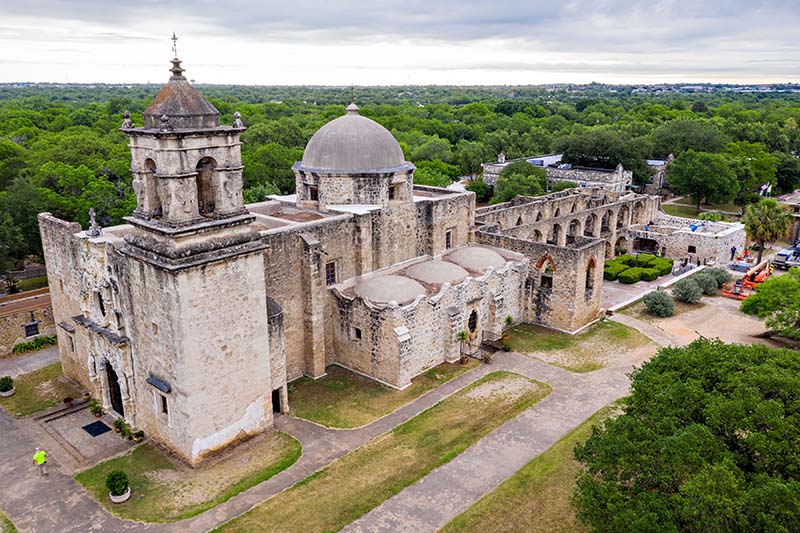(OSV News) — The Trump administration’s recent decision to withdraw the U.S. from the United Nations’ cultural agency comes just weeks ahead of a Catholic UNESCO World Heritage site anniversary celebration — and the exit stands to erode historic preservation efforts more broadly, experts told OSV News.
“I don’t know exactly what message it’s intended to send, but to me, it sends a disregard for the importance of preservation,” said Rebecca Simmons, executive director of Las Misiones, the nonprofit organization that under the Archdiocese of San Antonio safeguards four of the five historic colonial Spanish missions in San Antonio.
The missions — which include Mission Valero, the Alamo — comprise a single UNESCO World Heritage Site, and will mark the 10th anniversary of that designation Sept. 3-7. Four of the missions are active parishes.
World Heritage Program Began in 1972
UNESCO’s World Heritage program is central to the organization’s commitment — articulated in the international Convention concerning the Protection of the World Cultural and Natural Heritage, adopted by UNESCO in 1972 — to identify and preserve cultural and natural heritage deemed to be “of outstanding value to humanity,” according to the agency’s website.
Currently, there are 1,248 UNESCO World Heritage sites, including Vatican City, the Old City of Jerusalem and its walls, and a number of churches, cathedrals, monasteries and missions in various nations.
On July 22, State Department spokesperson Tammy Bruce announced that effective Dec. 31, 2026, the U.S. will end its involvement with UNESCO, which stands for United Nations Educational, Scientific and Cultural Organization.
The State Department said in its media release participation in UNESCO is “not in the national interest of the United States,” claiming that the organization advances “divisive social and cultural causes” and aims “at odds with our America First foreign policy.”
UNESCO Recognizes ‘State of Palestine’
The release also cited UNESCO’s “decision to admit the ‘State of Palestine’ as a Member State” as “highly problematic, contrary to U.S. policy,” and contributing “to the proliferation of anti-Israel rhetoric within the organization.”
While the withdrawal is not unprecedented — Congress axed UNESCO funding under the Obama administration, and the U.S. exited the agency in 2017 under the first Trump administration, later returning under the Biden administration — the move was lamented by Simmons and other experts with whom OSV News spoke.
UNESCO World Heritage recognition of the San Antonio Missions “was a huge thing to our city,” said Simmons. “We were the only designated site in the state of Texas.”
Attaining that international recognition took “years of work to get together all the required information, to make the points and the argument that’s presented to the committee, that indeed you are special (as a site),” she said. “So we considered it very important as an international recognition of this site culturally, not only to the United States, but to the world.”
U.S. Withdrawal Does Not Affect Funding
Simmons noted that the Trump administration’s UNESCO withdrawal does not endanger the missions’ designation, nor does it affect any funding.
Gov. Edwin Concha of Taos Pueblo in New Mexico — another U.S.-based UNESCO World Heritage site that includes a Catholic church, the San Geronimo Chapel — also confirmed the same.
“We got funding from UNESCO about 20 years ago,” said Concha. “We haven’t gotten any kind of funding from UNESCO since.”
He noted that the Taos Pueblo has a preservation department and relies “on funding through our own tourism office.”
Archaeologist and filmmaker Ian Kuijt of the University of Notre Dame told OSV News that the U.S. UNESCO exit was “a shortsighted and really poorly thought out” decision, especially since “the United States is in a position to be able to lend expertise for documenting world heritage.”
‘Important Contributions’ to Education
“Those are really important contributions to not only global heritage but also (to) U.S. education in general,” said Kuijt.
Both he and Simmons stressed that UNESCO World Heritage criteria — which must be upheld in order to maintain a given site’s designation, upon penalty of revocation — help to standardize historic preservation globally.
“A lot of the benchmarks for having the designation” demonstrate “not only the importance of a particular site but also that there’s some stewardship that’s going to take place,” said Kuijt. “How will water management take place if this site is susceptible to flooding? What plan exists in terms of the tourism impact?”
Kuijt added that there are also intergenerational concerns at the heart of historic preservation.
“Nobody is creating new archaeology sites anymore,” he said. “So whether you’re talking about Notre Dame Cathedral in Paris or the Grand Canyon or Roman ruins these are finite resources — and once they’re destroyed, they’re destroyed. There has to be an attempt to be able to identify and assess them in terms of their bigger contributions to world knowledge, and a shepherding of that (process). And that takes attention and funding, and that’s what UNESCO does.”
Gina Christian is a multimedia reporter for OSV News. Follow her on X @GinaJesseReina.




